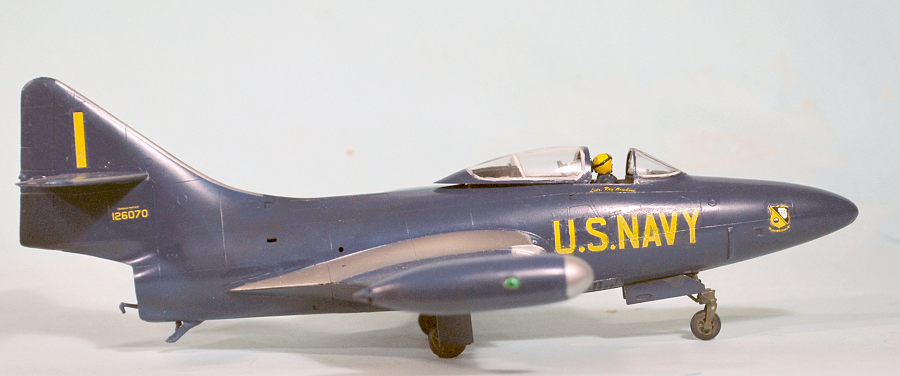
Monogram 1/48 F9F-5 Panther
| KIT #: | 5456 |
| PRICE: | $14.00 'used' |
| DECALS: | One option |
| REVIEWER: | Tom Cleaver |
| NOTES: | 2024 release. High-end limited run, photoetch |

| HISTORY |
The Blue Angels and the F9F Panther:
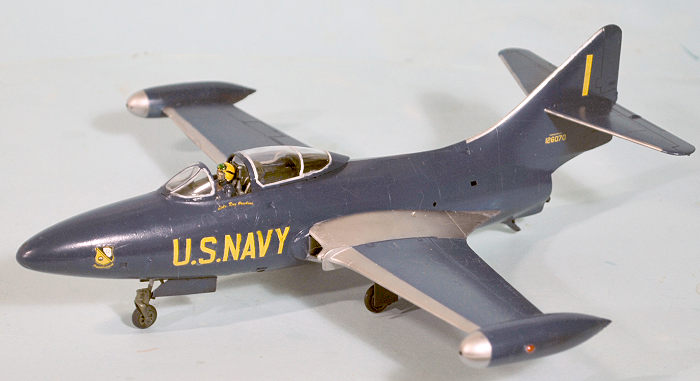 The Grumman
Panther, being the first fully-oprational carrier based jet fighter in the
Navy, was quickly adopted by the Blue Angeles, who used the F9F-2 Panther
for the 1949 season, performing also in 1950 and 1951 before the unit was
called to acive duty for the Korean War. With the war winding down in 1953 -
along with a need to create some public enthusiasm for Naval Aviation - the
tam was reconsituted in February 1953, equipped with the F9F-5 Panther, the
newest version of the standard Navy fleet fighter.
The Grumman
Panther, being the first fully-oprational carrier based jet fighter in the
Navy, was quickly adopted by the Blue Angeles, who used the F9F-2 Panther
for the 1949 season, performing also in 1950 and 1951 before the unit was
called to acive duty for the Korean War. With the war winding down in 1953 -
along with a need to create some public enthusiasm for Naval Aviation - the
tam was reconsituted in February 1953, equipped with the F9F-5 Panther, the
newest version of the standard Navy fleet fighter.
The team flew their first show with the F9F-5 in May 1953 at NAS Nashville. The F9F-5 was used for the 1953 and 1954 seasons, before the Panther was replaced by the F9F-8 Cougar beginning with the 1955 season.
On Navy Day, October 27,1954, the Blue Angels performed at NAS Buckley Field in Denver, Colorado. It was their last performance in the F9F-5 Panther. My father knew how much I liked the Panther - having convinced him to take me to see “The Bridges At Toko-ri” when it was released that year, and with a collection of four Hawk and Aurora anther models hanging from the ceiling in my bedroom - and we went to see the show, which was the first airshow I ever attended. I was suitably impressed by their show. I also remember that there was an F7U-3 Cutlass at the show, which impressed everyone when the pilot made low-speed low passes back and forth in front of the crowd with the airplane at a 40-degree angle of attack.
The Panther is still my favorite jet, as evidenced by the many models made from the Monogram release that are in the collection.
| THE KIT |
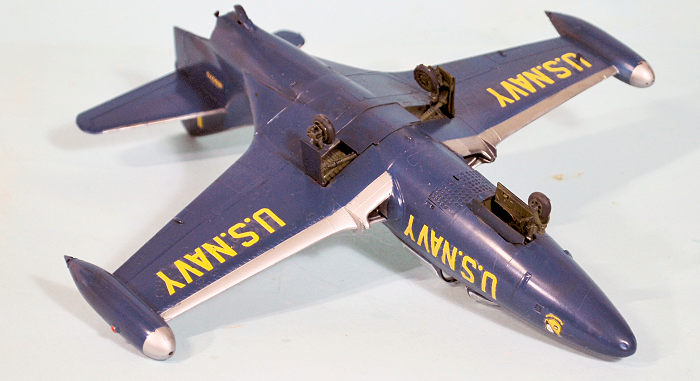 Monogram’s F9F-5
Panther was first released in 1990. It was the first 1/48 kit of the Panther
released since the old Aurora kit of the early 1950s. It is still the most
accurate F9F Panther kit in 1/48, its competition being the godawful
Trumpeter F9F-2, about which the less said the better. The kit comes from
the days of raised detail, and makes up easily into an excellent model,
since it only has 33 parts, not including your choice of bombs o rockets for
the underwing ordnance
Monogram’s F9F-5
Panther was first released in 1990. It was the first 1/48 kit of the Panther
released since the old Aurora kit of the early 1950s. It is still the most
accurate F9F Panther kit in 1/48, its competition being the godawful
Trumpeter F9F-2, about which the less said the better. The kit comes from
the days of raised detail, and makes up easily into an excellent model,
since it only has 33 parts, not including your choice of bombs o rockets for
the underwing ordnance
A number of decal sheets for the kit were released by SuperScale, Aeromaster and Eagle Strike, and these are still available at eBay prices from collectors.
Back in 1998, a friend of mine gave me a sheet of SuperScale decals for the 1952-54 team. I had always intended to do a Blue Angel Panther in memory of having seen them in person. The decal sheet made several moves with me until I rediscovered it in a box in 2023 and decided to finally make the model since I found a kit at a good price at Rare Plane Detective. I finally made good on the decision a year later.
| CONSTRUCTION |
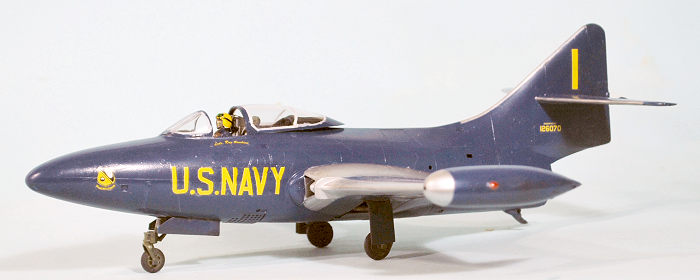 This kit is an easy
build, in fact it is so easy it would be a good first model for someone
re-entering the hobby after a long absence, or someone deciding to build their
first plastic model.
This kit is an easy
build, in fact it is so easy it would be a good first model for someone
re-entering the hobby after a long absence, or someone deciding to build their
first plastic model.
I assembled the kit per the instructions with no difficulty. Do be sure to put weight in the nose before sealing up the fuselage. I used three “cannon ball” fish weights in the extreme nose, which solved all problems.
I used Mr. Surfacer 500 on all the seams - centerline of the fuselage, upper and lower wing-to-fuselage, wing leading edge and tip tanks. The surface detail is the very petite raised variety, and I merely replaced what was lost in sanding the seams by scribing with a #11 X-acto. I did not open up the slots on the lower wing since I was not going to use the underwing ordnance pylons.
| COLORS & MARKINGS |
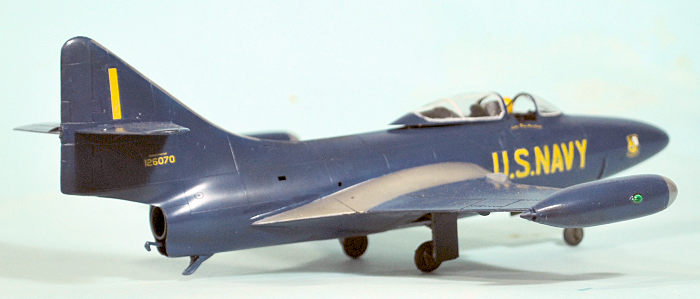 I first painted the
model with Tamioya “Gloss Aluminum” lacquer (LP-70). I let that dry overnight
before masking off and then painted the rest of the model with Mr Color C-328,
“Blue Angel Blue FS15050.”
I first painted the
model with Tamioya “Gloss Aluminum” lacquer (LP-70). I let that dry overnight
before masking off and then painted the rest of the model with Mr Color C-328,
“Blue Angel Blue FS15050.”
When I am dealing with an old decal sheet, I test the decals by dipping one I am not going to use in water to see if it is still OK. This sheet was not ok! I let the decal soak till it started to lift off the backing, at which point it exploded into a hundred little pieces in the bowl.
I used some Micro-Sol Liquid Decal Film on the rest of the sheet. This barely saved the day, as a couple of the “US Navy” still split into several pieces and had to be pieced together. Also, the dried liquid decal film was thick enough that the decal did not want to fully sit down on the surface over the raised panel detail. No amount of slicing and re-flooding with Micro-Sol would work and I had a near disaster when I tried a drop of Solvaset on one, which then started to melt before I washed off the Solvaset with Micro-Sol. I then used a 00000 brush to apply some of the Blue Angel Blue paint to the worst areas of silvering.
I decided to use the pilot, so I gave him a Blue Angel Blue flight suit and a Blue Angel Yellow helmet, suing Gunze-Sangyo H-413 “RLM04 Yellow.” I then attached the landing gear, put the ejection seat and pilot in the cockpit, and attached the canopy in the open position.
| CONCLUSIONS |
The Monogram kit stands the test of time. It is is an excellent kit that presents no problems whatsoever. I now have another “childhood memory” sitting on a display shelf.
Review Kit courtesy of my wallet.
76 November 2024
Back to the Previews Index Page
Back to the Previews Index Page